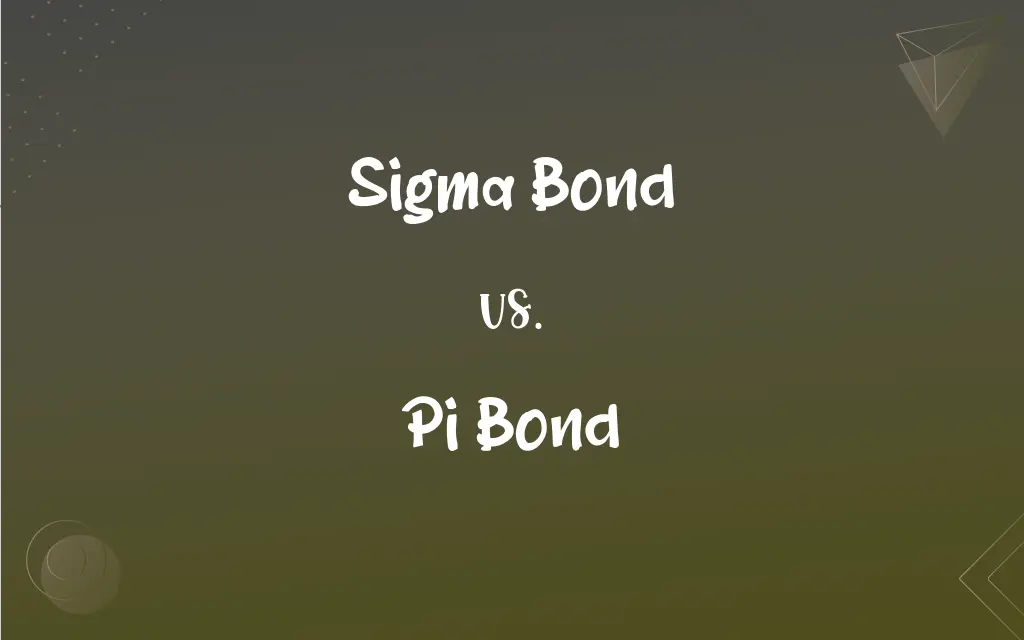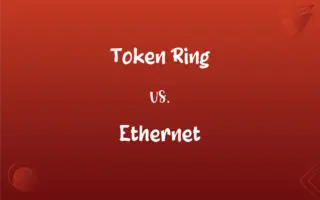Sigma Bond vs. Pi Bond: What's the Difference?
Edited by Aimie Carlson || By Harlon Moss || Updated on October 11, 2023
A sigma bond involves head-on overlap of orbitals, creating a single, linear bond between atoms, while a pi bond is formed by the lateral overlap of p-orbitals, creating a parallel bond above and below the sigma bond in double/triple bonded atoms.

Key Differences
Sigma bonds, formed by the end-to-end overlapping of atomic orbitals, establish the initial and required link between two atoms in molecular formation. On the other hand, pi bonds are generated through the side-to-side overlap of parallel p-orbitals, which can only exist in conjunction with a sigma bond and contribute to multiple bonding between atoms.
When examining the strength and characteristics of sigma and pi bonds, sigma bonds tend to be stronger due to their direct orbital overlap and are present in single, double, and triple bonds. Pi bonds, being formed by the less effective lateral overlap of orbitals, are generally weaker and only appear in double and triple bonds.
Molecular geometry and atomic hybridization are also influenced distinctly by sigma and pi bonds. The formation of sigma bonds typically involves sp hybridization and allows for free rotation of atoms around the bond axis. In contrast, pi bonds, which involve pure p-orbitals, restrict rotation due to the parallel overlap of the bonding orbitals.
The electron cloud distribution differs between sigma and pi bonds. Sigma bonds have an electron cloud symmetrically distributed along the bond axis, providing uniformity and enhanced strength. Pi bonds, however, have electron clouds above and below the bond axis due to the lateral overlap, which can result in regions of electron deficiency along the bond axis.
The impacts of sigma and pi bonds extend into molecular shapes and polarities. The sigma bonds often determine the fundamental shape of the molecule. Pi bonds, by restricting rotation and being additional to sigma bonds, influence molecular resonance, rigidity, and can impact the electronic properties of molecules.
ADVERTISEMENT
Comparison Chart
Orbital Overlap
Head-on, axial overlap
Side-to-side, parallel overlap
Presence in Molecules
In all single, double, and triple bonds
Only in double and triple bonds
Strength
Generally stronger
Weaker in comparison to sigma bonds
Electron Cloud
Symmetrically distributed along the bond axis
Distributed above and below the bond axis
Impact on Rotation
Allows free rotation
Restricts rotation
ADVERTISEMENT
Sigma Bond and Pi Bond Definitions
Sigma Bond
A bond allowing free rotation of atoms around the bonding axis due to its symmetrical electron cloud.
The sigma bond in ethane allows the molecule to exhibit free rotation about the C-C axis.
Pi Bond
A pi bond is a type of chemical bond where the P orbitals overlap on two adjacent atoms.
In ethylene (C2H4), the double bond consists of a sigma bond and a pi bond.
Sigma Bond
The initial and primary connection present in single and multiple bonds between atoms.
Every single bond, like that between the two carbon atoms in ethane (C2H6), is a sigma bond.
Pi Bond
The pi bond restricts the rotation of bonded atoms due to the parallel orientation of p-orbitals.
In ethene, the pi bond prevents free rotation around the C=C axis, keeping the molecule planar.
Sigma Bond
A bond involving atomic orbitals that align along the bond axis, contributing to bond strength.
The sigma bond in O2 is formed by the end-to-end overlap of orbitals from each oxygen atom.
Pi Bond
Pi bonds result from the side-to-side overlapping of parallel, unhybridized p-orbitals.
The pi bond in acetylene (C2H2) is part of the triple bond between the two carbon atoms.
Sigma Bond
A chemical bond formed by the head-on overlapping of atomic orbitals.
The single bond in H-H is a sigma bond.
Pi Bond
A pi bond typically exhibits weaker bonding compared to a sigma bond due to the lateral overlap of orbitals.
The C=C bond in ethylene consists of one strong sigma bond and one relatively weaker pi bond.
Sigma Bond
A bond characterized by electron density concentrated directly between the nuclei of bonding atoms.
In a chlorine molecule (Cl2), the sigma bond is formed by the head-on overlap of p-orbitals.
Pi Bond
The electron cloud of a pi bond is located above and below the bond axis, creating a distinct electron distribution.
In benzene (C6H6), the delocalized pi bonds form an electron cloud above and below the plane of the carbon ring.
FAQs
What is the main distinction between a sigma and a pi bond?
Sigma bonds involve head-on overlap of orbitals, while pi bonds involve side-to-side overlap.
Can a molecule have a pi bond without a sigma bond?
No, a pi bond always occurs together with a sigma bond between the same two atoms.
Which bond, sigma or pi, contributes more to bond strength?
Sigma bonds are generally stronger due to direct head-on overlap.
What orbital hybridization is associated with sigma bonds?
Sigma bonds involve sp, sp2, or sp3 hybridized orbitals.
Are pi bonds found in single bonds?
No, pi bonds are only found in double and triple bonds, never in single bonds.
How do sigma and pi bonds affect molecular shape?
Sigma bonds determine the basic skeleton, while pi bonds can influence the planarity and rigidity.
Which bond is typically formed first, sigma or pi?
Sigma bonds are always formed before pi bonds.
Which types of molecules generally contain pi bonds?
Unsaturated molecules, like alkenes and alkynes, contain pi bonds.
Can sigma bonds exist in all kinds of atomic orbitals?
Yes, sigma bonds can be formed using s, p, and hybridized orbitals.
How does the presence of a pi bond affect molecular rotation?
Pi bonds restrict rotational movement around the bond axis.
Can a single bond be a pi bond?
No, single bonds are always sigma bonds.
Are all triple bonds composed of one sigma bond and two pi bonds?
Yes, every triple bond contains one sigma bond and two pi bonds.
Is the electron cloud of a pi bond symmetrical along the bond axis?
No, it is distributed above and below the bond axis.
What is the role of p-orbitals in pi bonding?
Pi bonds are formed by the lateral overlap of unhybridized p-orbitals.
Are pi bonds always parallel?
Yes, pi bonds result from the parallel overlap of p-orbitals.
How do sigma and pi bonds differ in terms of electron distribution?
Sigma bonds have symmetrical electron distribution along the axis, while pi bonds have electrons above and below the axis.
Can sigma bonds participate in resonance structures?
Sigma bonds do not participate in resonance, only pi bonds do.
Are all double bonds composed of one sigma and one pi bond?
Yes, all double bonds contain one sigma bond and one pi bond.
Can pi bonds exist independently in molecules without sigma bonds?
No, pi bonds cannot exist without an accompanying sigma bond between the same two atoms.
Can a single molecule contain multiple pi bonds?
Yes, molecules like benzene contain multiple pi bonds.
About Author
Written by
Harlon MossHarlon is a seasoned quality moderator and accomplished content writer for Difference Wiki. An alumnus of the prestigious University of California, he earned his degree in Computer Science. Leveraging his academic background, Harlon brings a meticulous and informed perspective to his work, ensuring content accuracy and excellence.
Edited by
Aimie CarlsonAimie Carlson, holding a master's degree in English literature, is a fervent English language enthusiast. She lends her writing talents to Difference Wiki, a prominent website that specializes in comparisons, offering readers insightful analyses that both captivate and inform.































































